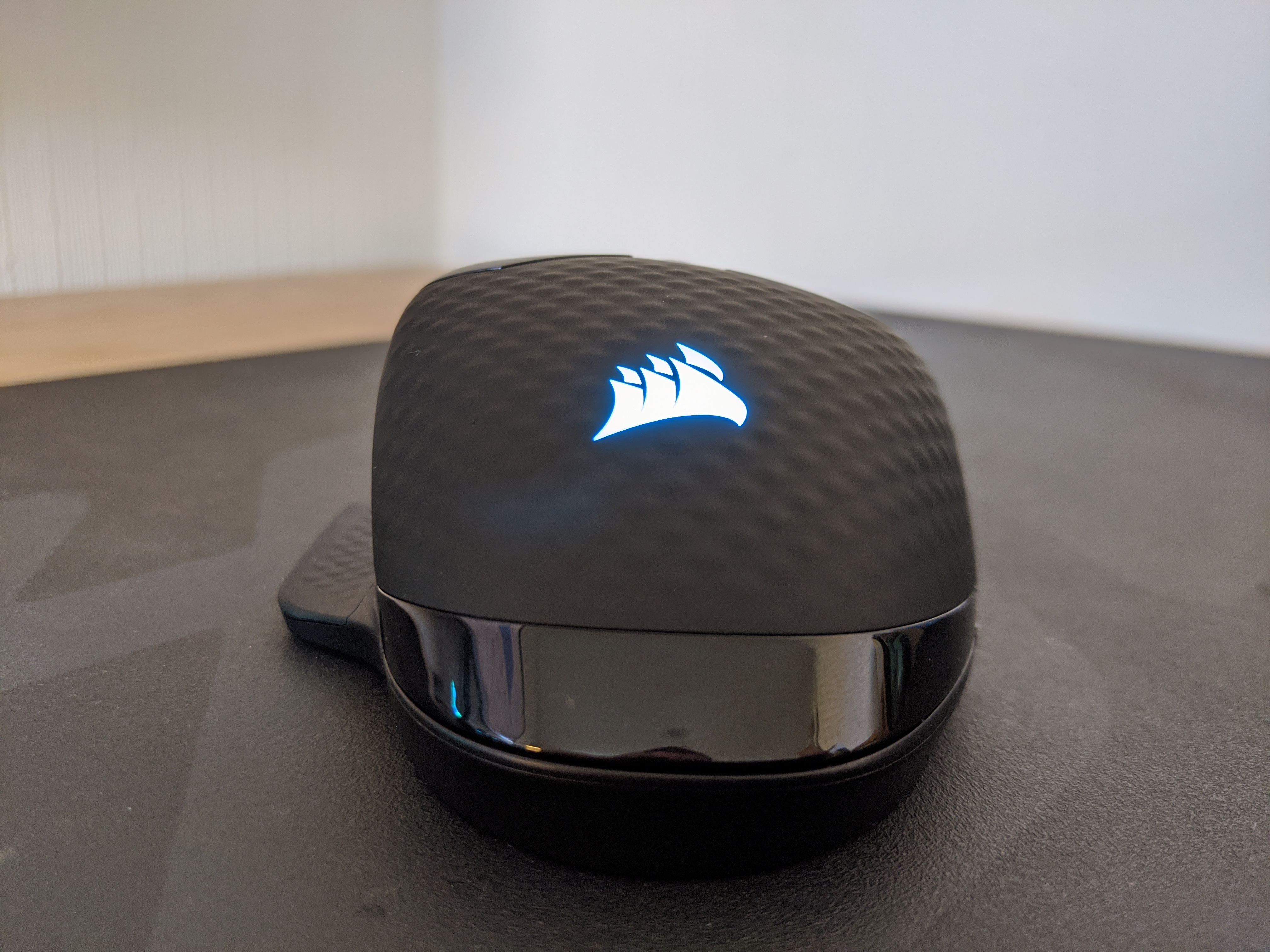Tom's Hardware Verdict
The Corsair Dark Core RGB Pro is a real front-runner in the wireless FPS mouse race, but its shape will turn off some gamers.
Pros
- +
Cleaner layout than non-Pro versions
- +
Smart 8-button layout
- +
Good battery life
Cons
- -
Shape favors palm grip
- -
Potential wireless issues
Why you can trust Tom's Hardware
When it comes to finding the best gaming mouse, it’s not just about performance, but functionality too. Blame it on Twitch or, perhaps, ever-growing eSports coverage, but many have come to accept that they may never be able to do what the pros do, so they might as well at least get a pointer with some neat tricks.
The Corsair Dark Core RGB Pro ($80/£105) appeals to that crowd. Like its predecessors, the Dark Core RGB (about $70 at the time of writing) and Dark Core RGB SE ($90), which adds wireless Qi charging to the package, this is a wireless or wired design. You have the option of connecting via a USB Type-A cable, Corsair’s Slipstream wireless technology via a USB Type-A dongle or Bluetooth. But in addition to a revamped look, the Dark Core RGB Pro announced today adds a more aggressive sensor that ups the CPI count from 16,000 to 18,000 and doubles the polling rate to 2,000 Hz.
Preventing it from being the best wireless mouse is in its wireless connectivity. We don’t see a “Pro,” as the model name calls for, or any gamer ditching more reliable rivals.
Corsair Dark Core RGB Pro Specs
| Sensor Type | Optical |
|---|---|
| Sensor Model | PixArt PAW3392 |
| Sensitivity | 18,000 DPI |
| Polling Rates | 2,000 Hz |
| Lift-off Distance | 2mm |
| Programmable Buttons | 8 |
| LED Zones | 9 RGB zones |
| Connectivity | Bluetooth 4.0, Corsair Slipstream (USB Type-A dongle), removable USB Type-A cable |
| Cable | Removable USB Type-A cable; 1.5m USB Type-C charging cable |
| Measurements (LxWxH) | 5 x 3.5 x 1.7 inches (127 x 89 x 43.2mm) |
| Weight | 4.96 ounces (133g) |
Design and Comfort
The Dark Core RGB Pro uses a bespoke design with an aesthetic that will draw strong opinions. But with its handy layout of its 8 programmable buttons, the design is fitting for FPS gamers who want to drop a cable from their set-up, while still having the option to go wired in highly competitive situations.


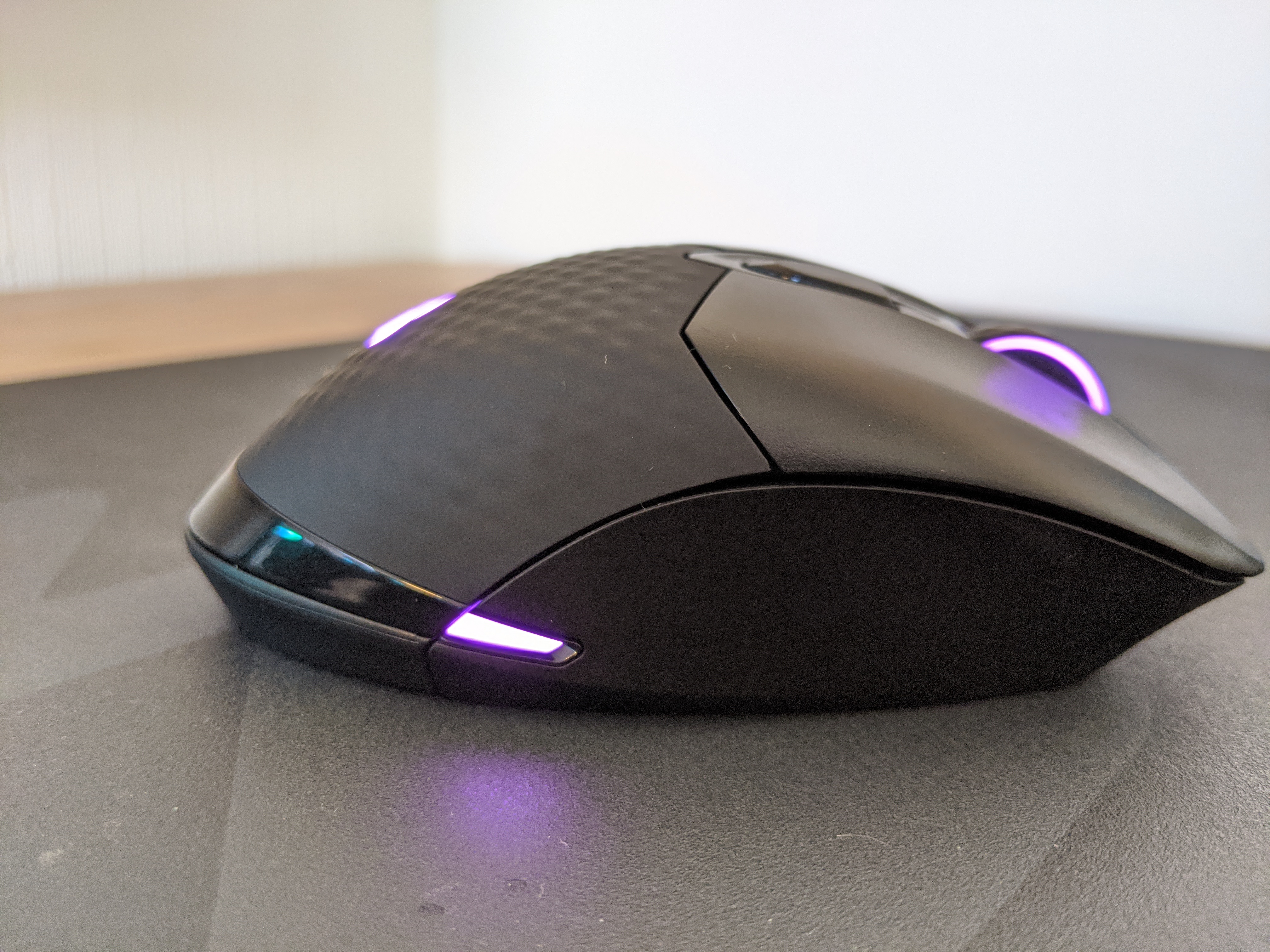

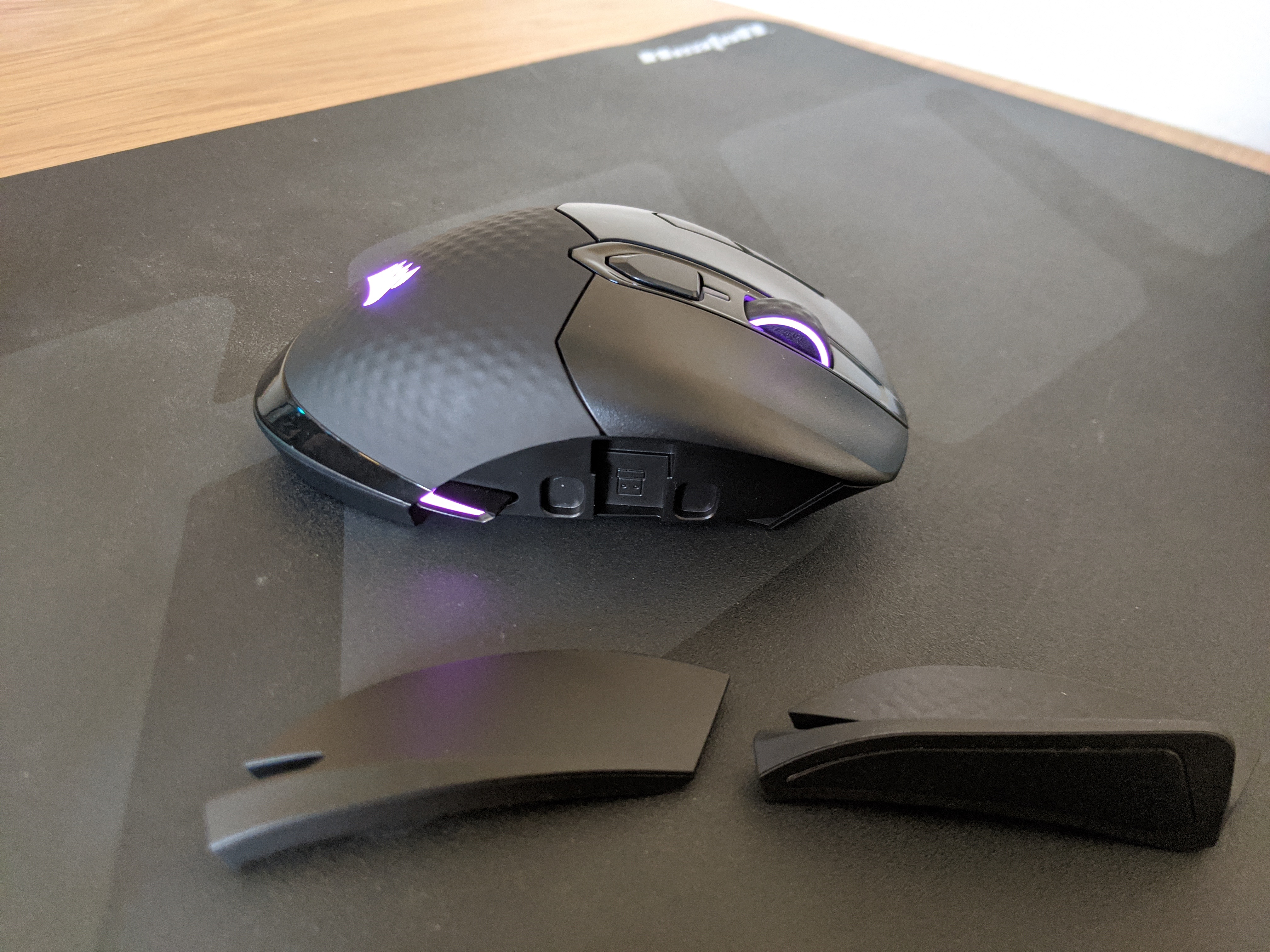
Unlike the standard Dark Core RGB models, the Dark Core RGB Pro ditches the busy thumb-pad for a cleaner look. That translates to fewer areas for grime to build up. A single high-gloss band at the very rear and a small strip between the left and right mouse buttons are the only reflective surfaces, with the buttons themselves a muted matte black. The rear and left side panels have a textured rubber finish. Those rubber areas felt comfortable during my testing, and the mouse didn’t slip around in my hand when things got clammy (CS:GO gets tense. Sue me.)
It is, of course, against the law to release a gaming peripheral without some form of RGB lighting. The Dark Core RGB Pro’s RGB comes via 9 individually programmable zones. The overall look is less showy than the likes of the Glorious Model O, a honeycomb-style FPS mouse, and its rainbow bands, but restrained RGB is not a bad thing, and it’s very easy to configure custom lighting patterns in Corsair’s iCue software.
At 1.7 inch (43.2mm) tall, the Dark Core RGB Pro is slightly taller than other mice. The Model O Minus, for example, is 1.42 inches (36.07mm) tall. However, it still felt svelte. Compared to the Corsair Nightsword RGB (5.1 x 3.4 x 1.7 inches), for example, the Dark Core RGB Pro is slightly easier to use with a palm grip, but marginally less comfortable in claw grip, since you’re keeping your claw in a higher position. That said, even as a hybrid/claw grip player with smaller hands, I still found this shape perfectly usable.
Get Tom's Hardware's best news and in-depth reviews, straight to your inbox.
The right side of the Dark Core RGB Pro has a modular, magnetized grip option. So if you prefer feet, so to speak, on both sides of the mouse, you can just flip off the flat modular panel and swap it out with the textured one provided in the packaging.
The button layout on the Dark Core RGB Pro is absolutely sensible here too, which isn’t categorically true of the standard version. The two DPI adjust buttons, which let you adjust DPI in single increments, are out of the way on the far side of the left mouse button, so you’re unlikely to hit them accidentally. But those buttons are also easy to feel for when you need them. Plus, a handy trio of lighting indicators accompanies the DPI adjust buttons so you can be sure of which DPI you’re using at a glance.
The forward/back web navigation buttons are bigger and more responsive than those of the Nightsword RGB. Meanwhile, pushing the mouse wheel in generates a satisfying click, and the profile switch button below it does as advertised. It’s a bit surprising not to find a low DPI ‘sniper mode’ toggle anywhere on this layout, given that the mouse is so clearly aimed at FPS players, but hand on heart this writer never uses them and nor do many (vastly more skilled) pro players. Just worth noting.
Gaming Performance
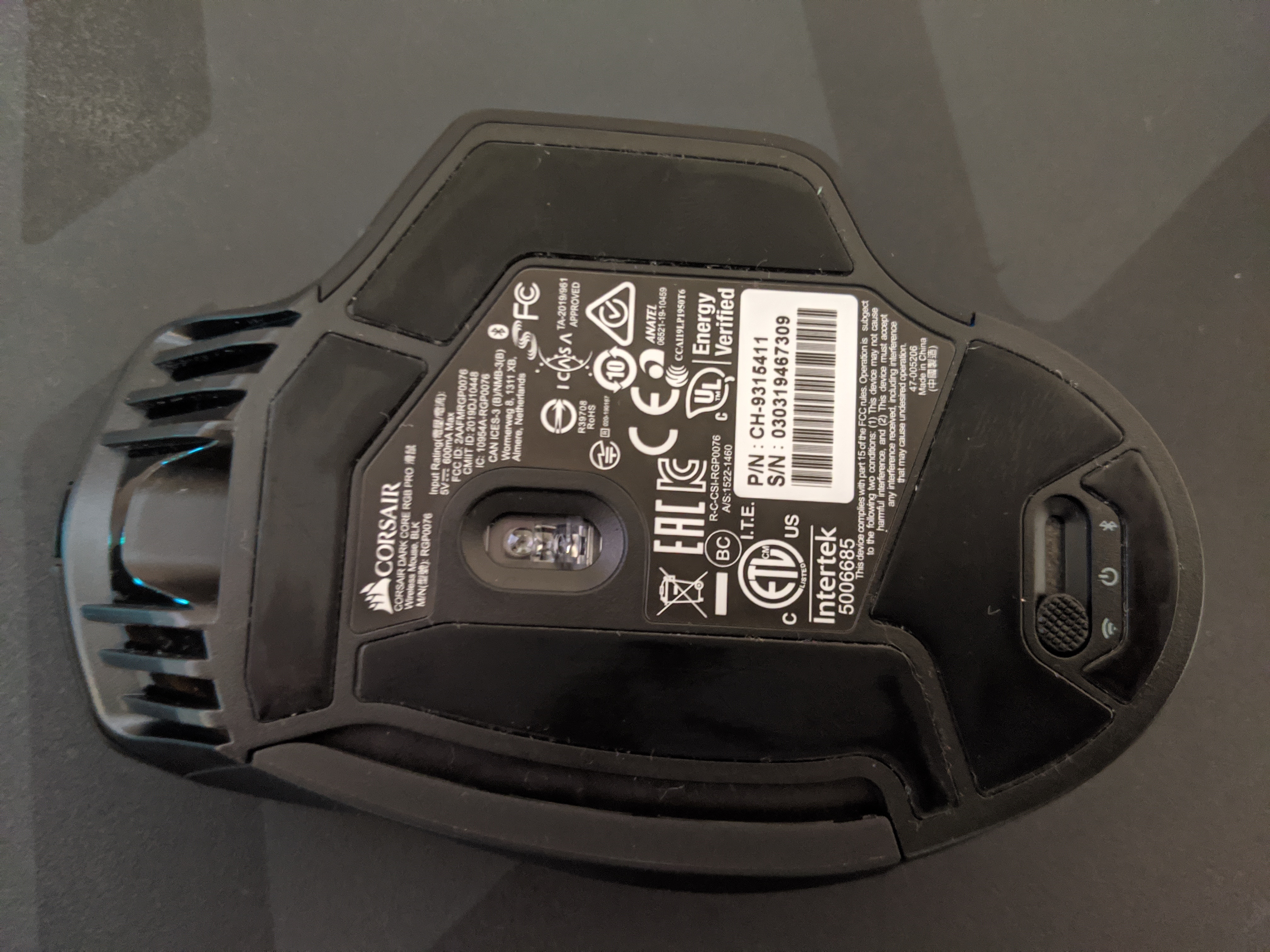

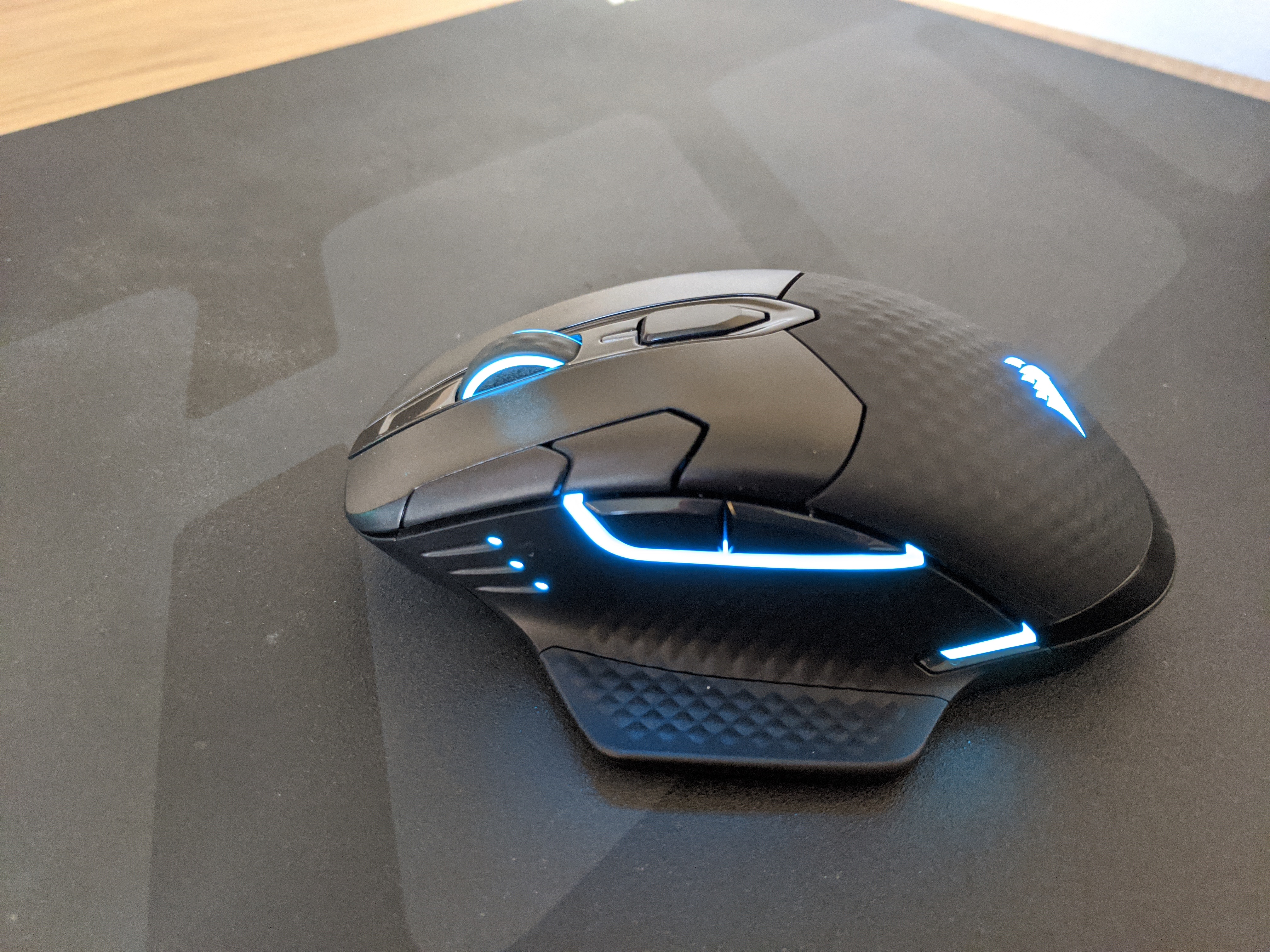
While the Dark Core RGB Pro offers the option for a wired connection, its biggest feature is its ability to switch to a wireless connection via Corsair’s Slipstream wireless dongle technology. Thankfully, Slipstream is good enough that for the vast majority of my time spent with the Dark Core RGB Pro, I forgot it was operating wirelessly.
Slipstream uses a bespoke protocol over 2.4 GHz wireless that’s supposed to enable twice the wireless packets to be sent, and Corsair claims latency as low as under 1ms. That held up in practice. When it came to lower DPIs in particular -- the lowest I went was 400 DPI -- the mouse was indistinguishable from a good wired model. At 800 DPI, performance felt silky-smooth, and although it took a few games in CS:GO for me to adjust to the Dark Core RGB Pro’s shape, there was no drop-off in my performance. But that’s just when everything worked.
Unfortunately, everything didn’t always work. While using a desktop with another dongle for a headset, plus a Wi-Fi receiver, our test sample was prone to bouts of prolonged stuttering and freezes that occurred about hourly when using the wireless dongle. If I was browsing the web or in the midst of a video editing task, this was an annoyance that fixed itself after a few seconds and didn’t require me to take out the USB dongle and put it back in. If I was in the middle of a game, however, it was a bigger issue. Generally, my fears about wireless dropout while using any device -- headsets, keyboards, mice or controllers -- are based on the bad old days 15 years ago when wireless tech simply wasn’t there. These days, it’s rare to experience noticeable stutters like this, and this undermines the Dark Core RGB’s whole endeavor as a competitive FPS mouse.
We reached out to Corsair about the issue, and while it said it hadn't encountered this issue before, it noted that it's common for wireless devices to suffer from interference from additional dongles. The spokesperson added that line-of-sight between the mouse and dongle is recommended.
Note that we may not have encountered this issue with the option to connect via Bluetooth 4.0. However, like many desktop PCs, the rig we’re testing this mouse on isn’t Bluetooth 4.0-compatible. We did still have the option to use the mouse’s USB Type-A connection.
The button layout and shape of the Dark Core RGB Pro worked well for gaming. Having easy-to-locate DPI cycling is a bonus in sniping-heavy battle royales, such as PUBG, where the pace of play is generally slow enough that you can get set up, look down your sights, then cycle to a lower DPI. It beats having to reach for an awkward sniper mode button. The broad PTFE areas on the underside worked especially well for flick-aiming in twitchier shooters, such as Quake Champions. The Dark Core RGB Pro’s 4.2-ounce weight isn’t adjustable but proved to be right in the sweet spot for motion-intensive titles. Moving between this and the Glorious Model O Minus (2.08 ounces) was a significant adjustment in terms of weight and shape, but the answer to which mouse is best will come down to personal preference ultimately.
Feature and Software
As always with Corsair gear, iCUE software provides further tweaking, including macros, customizable RGB lighting, button remapping, DPI adjustments and a few extras.
Particularly useful is Corsair’s surface calibration tool, which requires the USB-C cable to run and really has a tangible effect on smoothness once you run a simple test drawing spirals within a set speed. There’s also the angle snapping available via a tickbox. Don’t knock it ‘til you’ve tried it. It’s a much subtler effect than some seem to think, effectively anticipating when you’re trying to ‘draw’ a straight line with your mouse and helping you to do it. For many, it’s a step away from ultimate raw input control and, thus, useless, but some might find they land a few more headshots thanks to it.
Additionally, iCue offers a pointer speed precision enhancer, which has less in-game value but makes life easier if you spend a lot of time in video/audio editing programs.
You get three DPI profiles, each with three sensitivity settings, so if you really want to be organized you can set the parameters for your three most played games and just cycle between those profiles using the button under the mouse wheel.
There’s no polling rate control in iCUE at the moment though, which is a bit puzzling. Older versions (back when it was just CUE) had this functionality, so it’s not clear why it’s gone or when -- if ever -- it might return.
The priority right now must be on increasing the reliability of that 2.4 GHz wireless connection though. Whether Corsair can achieve that via firmware/iCUE remains to be seen.
Battery Life
Another upgrade the Dark Core RGB Pro offers over its standard version is extended battery life. While its predecessor is specced to last up to 24 hours without a charge, the Dark Core RGB is specced to last for up 50 hours without a charge, and during our testing that figure held up.
Additionally, the Pro version charges over USB-C instead of USB-A. Corsair includes the necessary cable.
Meanwhile, those with a Qi wireless charger may want to consider the SE version of the Dark Core RGB Pro. It supports Qi wireless charging, and with a Qi charging mouse pad (you can see recommendations in our best RGB mouse pads list), you could charge the mouse while gaming.
Bottom Line
The Corsair Dark Core Pro RGB is promising for gamers. Available for $79.99/£105, the new Dark Core RGB Pro is on the high end but is still cheaper than rivals, like Logitech’s G PRO ($150 at the time of writing) and Logitech G502 Lightspeed ($150). Corsair’s latest gets a boost from a smart 8-button layout that works well with FPS games. And it’s upgraded sensor kept up with me on the battlefield.
However. with multiple other wireless dongles connected to our system, we had stuttering problems with the 2.4 GHz wireless connection, which rendered this mouse really troublesome for gaming. Matters get even worse if you lack Bluetooth 4.0 capability. The wired option is also reliable, but part of what you're paying for here is flexibility.
But if you’re okay relying on a Bluetooth or wired connection or don't have a lot of wireless dongles you depend on already, the Dark Core RGB Pro offers a reliable sensor and easily-accessible programmable buttons.
MORE: Best Gaming Mice
MORE: Gaming Mice Reviews
MORE: Best RGB Mouse Pads
